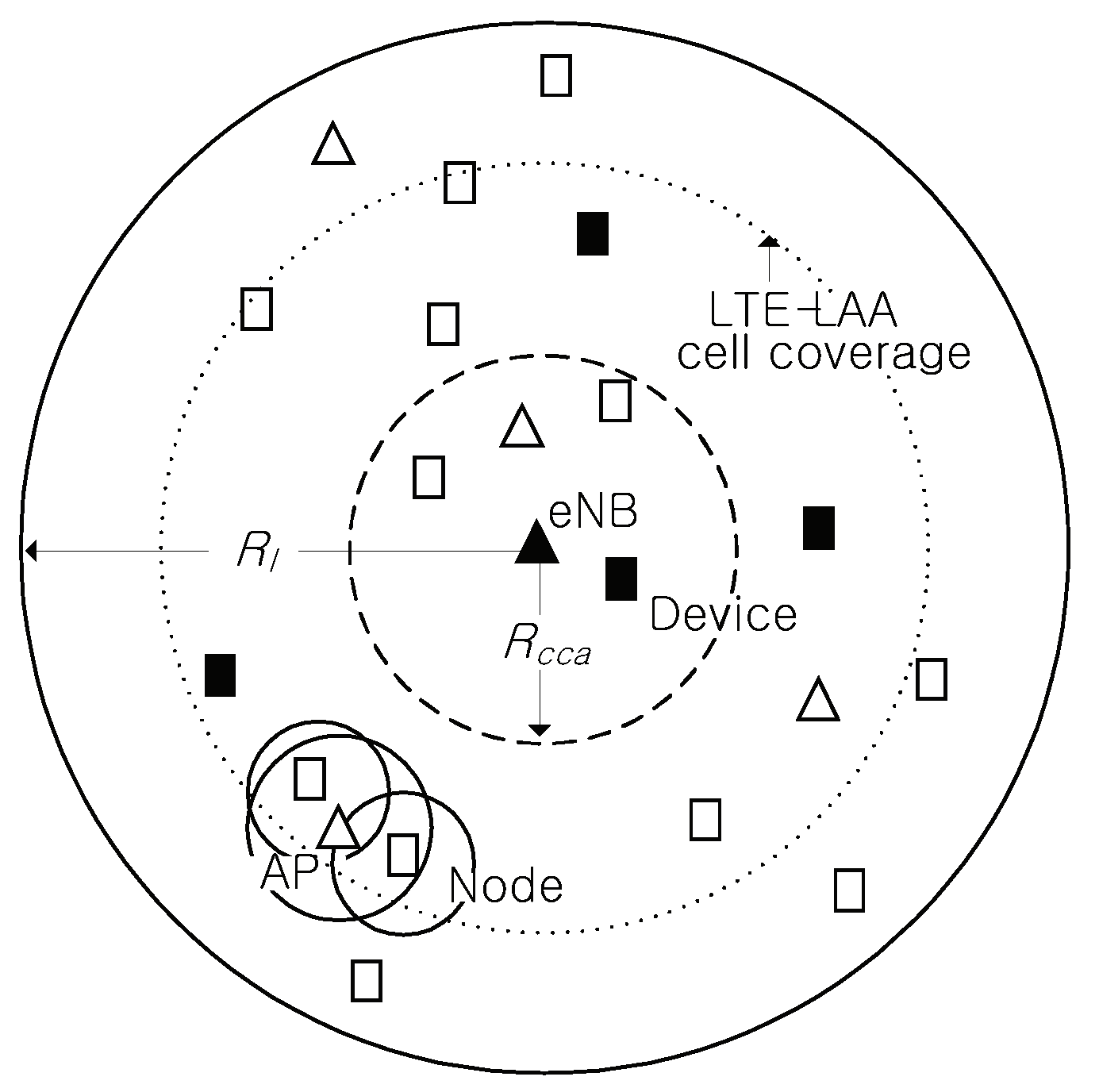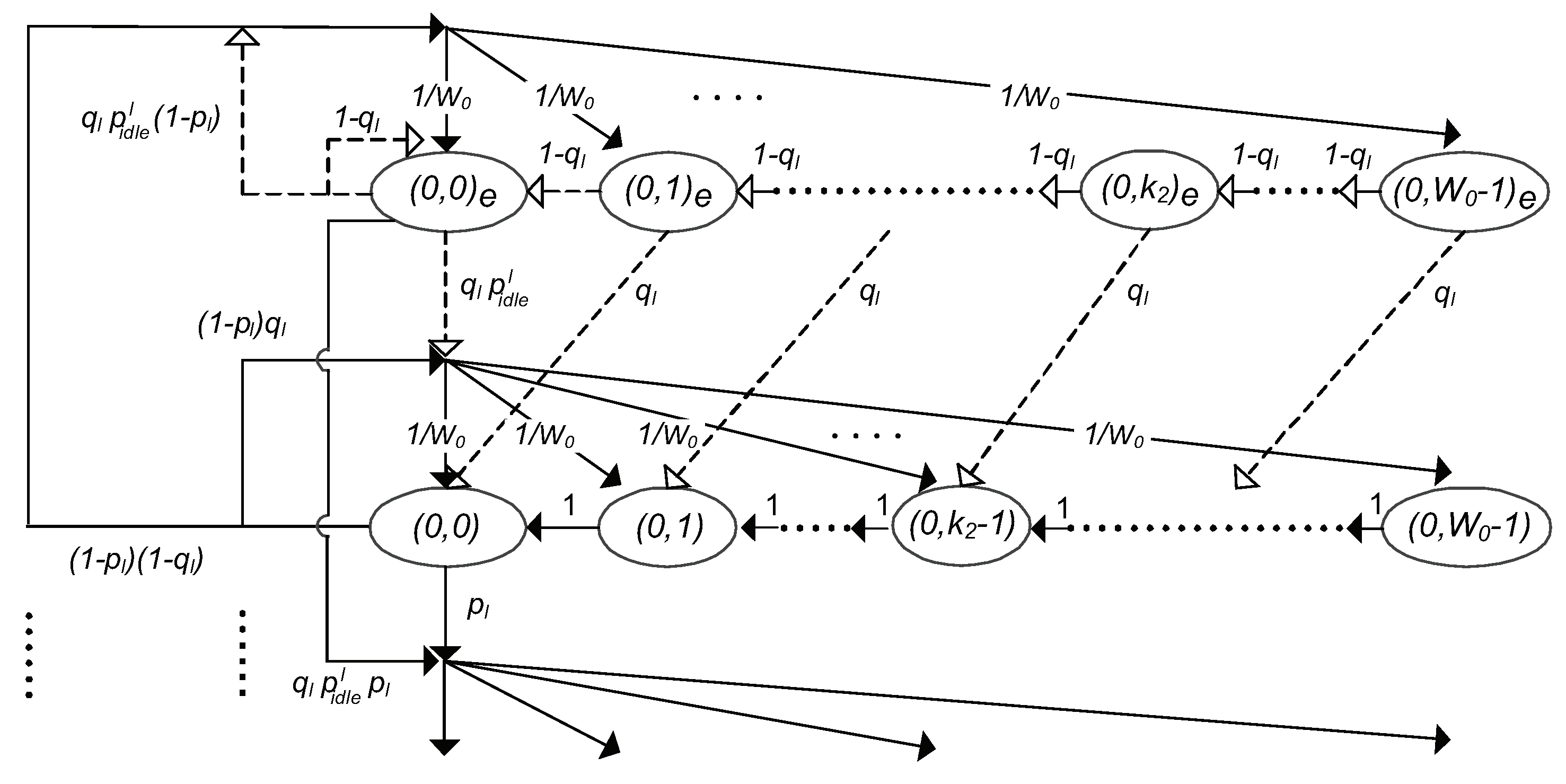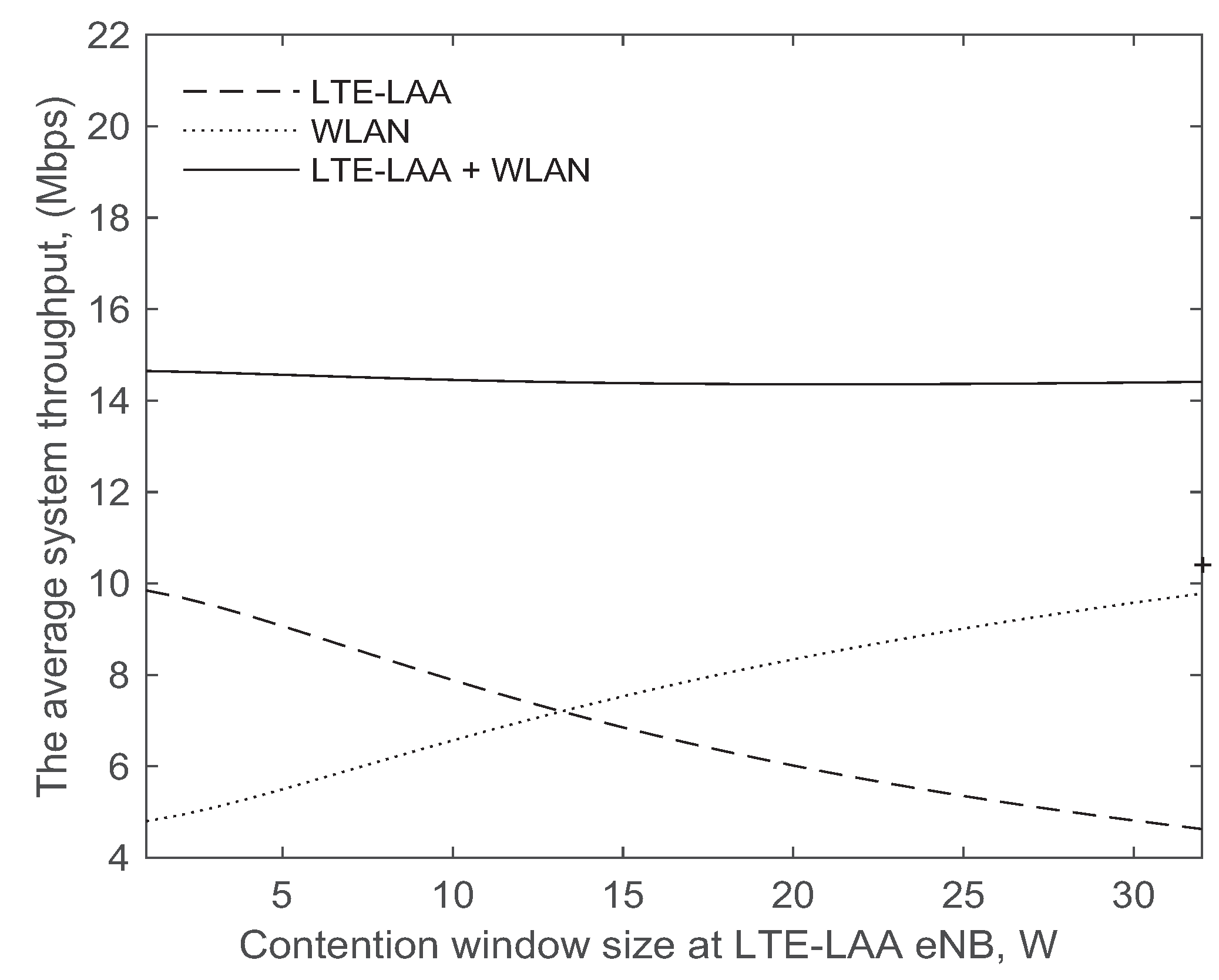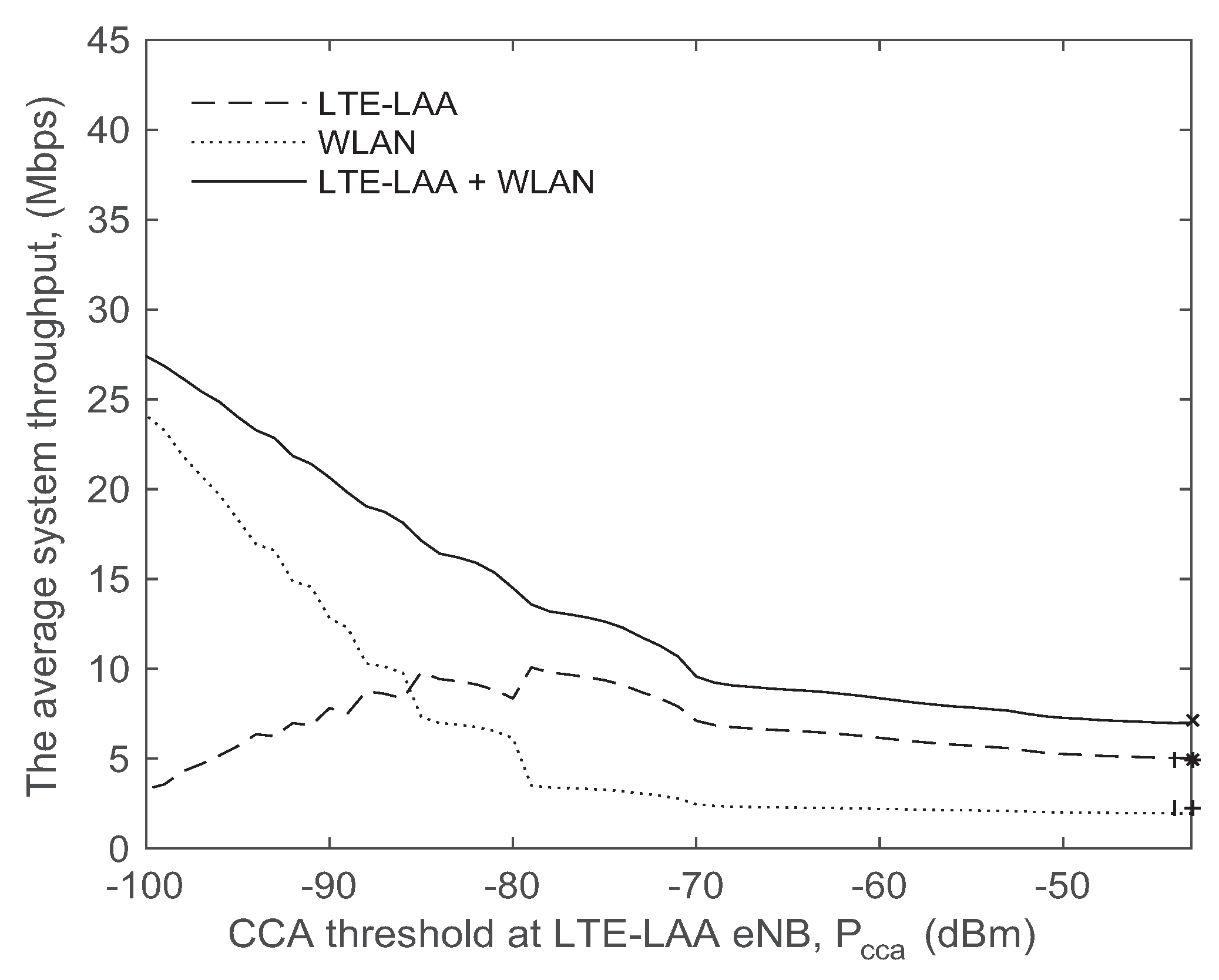We used a Markov chain model to analyze the throughput of LTE-LAA and WLAN systems in a scenario where a single LTE-LAA system shares the unlicensed spectrum with multiple WLAN basic service sets.
Figure 1 shows an LTE-LAA eNB located at the center, with multiple LTE-LAA devices distributed within the coverage area of the LTE-LAA cell, which supports only downlink transmissions from the LTE-LAA eNB to LTE-LAA devices. We define the CCA region as the area where WLAN transmissions are detectable by the LTE-LAA eNB, with
representing its radius. Additionally, we define an interfering region, where WLAN transmissions can interfere with LTE-LAA devices but remain undetectable by the LTE-LAA eNB;
denotes the distance from the LTE-LAA eNB to the outer boundary of this interfering region.
2.1. Random Backoff Operations in LTE-LAA eNB
LTE-LAA eNB competes with multiple WLAN nodes for channel access by utilizing channel sensing and backoff mechanisms similar to those employed in WLAN systems, as shown in
Figure 2.
The LTE-LAA eNB, when handling a new packet, first listens to the target channel to measure the energy level over a duration equal to the distributed inter-frame space (DIFS). If the measured energy level is below the predefined CCA threshold, the LTE-LAA eNB initiates transmission. Otherwise, if the channel is detected as busy, the LTE-LAA eNB continues monitoring until the channel is idle for a DIFS duration. Once the channel is deemed idle, the LTE-LAA eNB generates a random backoff time before transmitting to reduce the probability of collisions with packets transmitted by WLAN nodes. Furthermore, to prevent channel capture, the LTE-LAA eNB must wait for a random backoff interval between two consecutive new packet transmissions, even if the channel is sensed as idle during a DIFS duration. The LTE-LAA eNB operates on a discrete-time backoff scale, where the time following an idle DIFS is divided into fixed-length timeslots. The LTE-LAA eNB is allowed to transmit only at the beginning of each timeslot. For each packet transmission, the LTE-LAA eNB randomly selects a number from the range , where W is referred to as the contention window. The LTE-LAA eNB then counts down the corresponding number of idle timeslots before initiating transmission. The backoff counter decreases as long as the channel is sensed as idle. If a transmission is detected on the channel, the counter is “frozen” and resumes only after the channel has been idle for a DIFS duration. The LTE-LAA eNB initiates transmission when the backoff counter reaches zero.
Figure 2 illustrates an example scenario of the random backoff operations of an LTE-LAA eNB. The LTE-LAA eNB and a WLAN node share the same unlicensed channel. After completing a packet transmission, the LTE-LAA eNB waits for a DIFS duration and selects a backoff counter value of 7 before transmitting the next packet. In this scenario, we assume that the WLAN node transmits a packet in the middle of the timeslot corresponding to a backoff counter value of 5 for the LTE-LAA eNB. As a result of the channel being sensed as busy, the backoff timer is frozen at 5 and resumes decrementing only when the channel is sensed as idle for a DIFS duration. As illustrated in
Figure 2, the backoff counter of the LTE-LAA eNB remains frozen during the transmission of a WLAN node, which can cause the time interval between two consecutive timeslot beginnings to be significantly longer than the timeslot size,
. Specifically, this interval equals the timeslot size,
, when no other WLAN nodes are transmitting, but it corresponds to the time between two consecutive backoff counter decrements when transmissions from other WLAN nodes are present.
2.2. Markov Chain Model for Random Backoff Operations in LTE-LAA eNB
In this section, referring to [
15], we use a Markov chain model to study the random backoff operations of the LTE-LAA eNB, as described in
Section 2.1, under non-saturated conditions where packets are not always present in the queue of the LTE-LAA eNB. We then derive the stationary probability
, representing the probability of the LTE-LAA eNB transmitting a packet during a randomly selected timeslot.
The LTE-LAA eNB shares an unlicensed channel with multiple WLAN nodes. To avoid collisions with packets transmitted by other WLAN nodes, the LTE-LAA eNB generates a random backoff counter before transmitting. Let denote the stochastic process representing the backoff counter for the LTE-LAA eNB. A discrete, integer-based time scale is adopted, where t and represent the beginning of two consecutive timeslots. The backoff counter of the LTE-LAA eNB decreases at the beginning of each timeslot.
Assuming non-saturated conditions where the LTE-LAA eNB does not always have packets waiting in its queue for transmission, our Markov chain model, referring to [
15], includes two types of states: the post-backoff stage and the backoff stage. The post-backoff stage represents the state where the LTE-LAA eNB has no packets in its queue awaiting transmission, while the backoff stage corresponds to the state where a packet is waiting to be transmitted. Let
be the stochastic process indicating whether the LTE-LAA eNB is in the post-backoff stage or the backoff stage at time
t. Specifically, if
, it indicates that the LTE-LAA eNB is in the post-backoff stage at time
t, and if
, it indicates that the LTE-LAA eNB is in the backoff stage at time
t.
The bidimensional process
can be represented using a discrete-time Markov chain, as illustrated in
Figure 3. The stochastic process
, representing the post-backoff stage or the backoff stage, takes values of −1 or 0, while the stochastic process
, representing the backoff counter, ranges from 0 to
. Thus, the state space, consisting of a finite set of states, can be expressed as follows:
Let
denote the probability of transitioning from state
to state
. In our Markov chain model, since the transition probabilities are independent of the time at which the transition occurs, the transition probability
can be expressed as follows:
In the backoff states, while the medium is sensed as idle, the state
is decremented by 1 to
in each timeslot. However, in the post-backoff states, if there is at least one packet awaiting transmission at the start of a timeslot, the state
transitions to the backoff state
. Otherwise, similar to the backoff states, the state
is decremented by 1 to
. Thus, we have for
where
q is the probability that there is at least one packet awaiting transmission at the start of each backoff counter decrement.
In the backoff state
, the LTE-LAA eNB transmits; following the transmission, it returns to the post-backoff state with a new
, i.e., state
, selected from
, provided no collision occurs and there are no packets awaiting transmission in the queue. Thus, this transition probability is
where
p is the probability of a collision occurring between transmissions from the LTE-LAA eNB and WLAN nodes within the CCA range. However, if a collision occurs, or if the transmission is successful and there is at least one packet remaining in the buffer, the LTE-LAA eNB reenters the backoff state with a new
chosen within the range
.
In addition, we consider the state
, where post-backoff is complete but there are no packets awaiting transmission in the buffer. Suppose a packet arrives in the buffer while in state
. If the medium is sensed as busy during an additional timeslot, the LTE-LAA eNB enters a new backoff state
; otherwise, it transmits immediately. If a collision occurs following the transmission, the LTE-LAA eNB again enters a backoff state
. Therefore, the probability of this transition is
where
represents the probability that the medium is sensed as idle during a timeslot. If the transmission succeeds without a collision, the LTE-LAA eNB returns to the state
, where
is selected from
. Thus, we have
Let
P denote the transition probability matrix of the Markov chain model illustrated in
Figure 3. Then, using Equations (
3)–(
7), we can express the transition probability matrix
P as shown in
Figure 4.
Let
and
denote the stationary probabilities of being in the states
and
, representing the backoff and post-backoff states, respectively. Then, these stationary probabilities can be expressed as follows:
Taking into account all stationary state probabilities, we derive the following normalization condition:
Using Equations (
3)–(
7), we express all stationary state probabilities in terms of
. Then, by applying the normalization equation in Equation (
9), we can further express
in terms of
p,
,
q, and
W.
A transition into the state
from the state
occurs as described in Equation (
7). In addition, a transition into the state
from the state
occurs as described in Equation (
4). Thus, the stationary probability of the state
is given by
Referring to Equation (
3), for
, we can express
as
, while for
, the relation
holds. By straightforward recursion, this leads to
. Thus, using Equation (
10), we have
Using these equations, we determine the first sum in Equation (
9),
Referring to Equations (
5) and (
6), in the same manner as Equation (
10), the stationary probability of the state
is given by
We can express
in terms of
and
because
for
. Thus, using Equations (
10), (
11), and (
13), the second sum in Equation (
9) is
The LTE-LAA eNB attempts transmission in the following two cases: (i) when a packet arrives in the buffer and the medium is sensed as idle in the state
, and (ii) when the LTE-LAA eNB is in the state
. Thus, the transmission probability is
. Using Equation (
11), it can be expressed as follows:
where
can be expressed in terms of
p,
,
q, and
W from Equations (
9), (
12), and (
14). Thus, given
p,
,
q, and
W, we can calculate the transmission probability of the LTE-LAA eNB using Equation (15). In
Section 2.4, the transmission probability
is used to calculate the throughputs of both LTE-LAA and WLAN systems.
2.3. Interference Measured at an LTE-LAA Device
It is assumed that the LTE-LAA eNB uses an omnidirectional antenna, as illustrated in
Figure 5; its transmission power, denoted by
, is fixed in accordance with regulations for unlicensed band usage. Let
represent the received signal power at an LTE-LAA device
u from the LTE-LAA eNB, and let
denote the cumulative interference from concurrent transmissions by multiple WLAN nodes. Then,
, where
K is a constant and
is the propagation loss exponent [
16]. The signal to interference plus noise ratio (SINR) at the LTE-LAA device
u can then be obtained as follows:
where
is the noise.
To calculate
, we approximate the interference from discrete WLAN nodes as a continuous field with an equivalent node density [
16,
17]. In this model, the continuous field is defined by the density of interfering WLAN nodes, denoted as
. Let
represent the set of WLAN basic service sets in the interfering region, and
represent the channel utilization of each WLAN basic service set
i. Then, the density is given by
, where
is the area of the interfering region, calculated as
[
16].
We consider a scenario where an LTE-LAA device experiences interference from transmissions by WLAN nodes located in the interfering region, as shown in
Figure 5a. Let
represent the distance between the LTE-LAA device and an interfering WLAN node.
Figure 5b depicts a polar coordinate system centered at the LTE-LAA eNB. Let
y be the distance between the LTE-LAA eNB and an infinitesimal element of the interfering region, which is given by
where
is a scaling factor. When
and
, the infinitesimal element is located at the boundary of the CCA range and the outer boundary of the interfering region, respectively.
Let
denote a polar angle in the polar coordinate system; then, given a scaling factor
and a polar angle
, the distance
can be obtained as follows:
As shown in
Figure 5b, an infinitesimal element of the interfering region can be given by
From the equation above, the total number of interfering WLAN nodes contained in the infinitesimal element is given by
; then, using Equation (
18), their interference power is
where
is the transmit power of a WLAN node. Thus, in the interfering region, the average interference power measured at the LTE-LAA device is
Here, referring to Equation (
17), we use the relation
.
Thus, using Equations (
16) and (
20), we can calculate the average SINR for each LTE-LAA device, which will then be used to estimate the data rate of the LTE-LAA system in
Section 2.4. We adopt the Shannon capacity as the LTE-LAA rate function, allowing us to estimate the LTE-LAA rate as follows [
18,
19]:
where
B represents the bandwidth of a subchannel, and
is the system efficiency factor accounting for various system-level overheads. The parameters
and
together adjust for the SINR implementation efficiency of the modulation and coding schemes [
19].
2.4. Throughput of LTE-LAA and WLAN Systems
In this subsection, we analyze the throughput of LTE-LAA and WLAN systems based on the random backoff operations of WLAN nodes and the random backoff operations of the LTE-LAA eNB, as explained in
Section 2.2.
The WLAN nodes employ random backoff operations, similar to those of LTE-LAA eNB described in
Section 2.1, to control access to the shared wireless channel. The study in [
15] analyzed the random backoff operations of WLAN nodes using a non-saturated Markov chain, with post-backoff and backoff stages denoted as
and
, respectively.
Figure 6 illustrates the first two stages of the Markov chain model proposed in [
15]. The following notations are used in this subsection:
: Backoff stage number.
: Value of the backoff counter.
: Minimum contention window size.
: Stationary probabilities of being in the post-backoff states .
: Collision probability of WLAN node l.
: Probability of at least one packet awaiting transmission in the buffer of WLAN node l in a timeslot.
: Probability that WLAN node l senses the medium as idle in a timeslot.
: Probability that WLAN node l is attempting transmission in a timeslot.
: Set of WLAN nodes located within the CCA ranges of the nodes in the set T, which does not include the nodes in the set T.
: Set of WLAN nodes located in the CCA range of the LTE-LAA eNB.
Then, referring to [
15], the transmission probability
can be obtained as follows:
To simplify the analysis, we disregard the hidden-node problem; specifically, we assume that, for any transmitting and receiving pair of WLAN nodes, the receiver can only sense transmissions from WLAN nodes located within the CCA range of the transmitter. Thus, considering the transmissions of both the LTE-LAA eNB and WLAN nodes within the CCA range of transmitter
l, the collision probability
in Equation (
22) is given by
where the transmission probability of the LTE-LAA eNB,
, can be obtained from Equation (15). Using Equation (
23),
.
The probability that at least one WLAN node within the CCA range of the LTE-LAA eNB attempts transmission is given by
The channel usage state may be occupied due to either a successful transmission or a collision among transmissions; otherwise, the medium may be idle. Using Equations (15) and (
24), the probability that the LTE-LAA eNB or at least one of WLAN nodes will attempt transmission is
The probabilities that the LTE-LAA eNB and the WLAN nodes within the CCA range transmit without collision are, respectively,
The probability that the transmission from the LTE-LAA eNB is interfered with by transmissions from WLAN nodes within the CCA range is given by
The probability of a collision occurring among transmissions of WLAN nodes within the CCA range is
Suppose that
WLAN nodes, labeled
, are attempting transmission in a timeslot. For all these transmissions to succeed, the LTE-LAA eNB must remain idle, each WLAN node must be outside the CCA range of the others, and none of the WLAN nodes in the set
should transmit. Thus, the probability of all these transmissions succeeding is
where
and
is an indicator function. If each node in
T is outside the CCA range of every other node in
T, then
; otherwise,
.
Using Equation (
29), the probability that all transmissions succeed when some WLAN nodes located within the CCA range of the LTE-LAA eNB transmit in a timeslot is
Using the equation above, the probability of a collision occurring among transmissions from WLAN nodes located within the CCA range of the LTE-LAA eNB is
Let
denote the expected time for a transmission by the LTE-LAA eNB, and let
and
denote the expected times for a successful transmission by a WLAN node and a collision experienced by the WLAN node, respectively. Using
,
,
,
, and
in Equations (
25)–(28), (
30), and (
31), respectively, the expected time spent per channel state is
where
is the timeslot size.
Let
denote the data rate of the WLAN system, as defined in the 802.11 standard [
20]. The throughput of the WLAN system can then be obtained as follows:
Here,
represents the portion of
during which data is transmitted.
Unlike for the WLAN system, we account for throughput degradation due to collisions to estimate the throughput of the LTE-LAA system. Let
represent the average interference power caused by WLAN nodes within the CCA range. Then, similarly to Equation (
20), we can calculate
; however, in this case,
and
. Thus,
is given by
where
represents the average number of WLAN nodes transmitting simultaneously within the CCA range. Let
denote the SINR measured during a collision. Then, referring to Equation (
16), it is given by
. Thus, using Equation (
21), the throughput of the LTE-LAA system is
Here,
represents the portion of
during which data is transmitted, and
denotes the SINR measured when there is no interference from WLAN nodes within the CCA range, which can be calculated using Equation (
16). If multiple LTE-LAA devices are present,
and
are computed as the average SINRs across all LTE-LAA devices.















